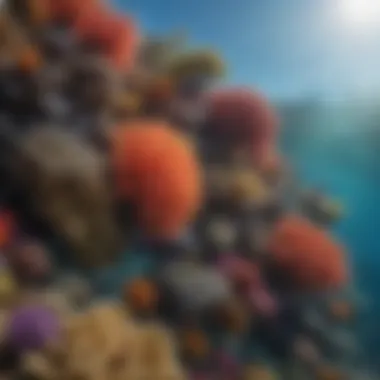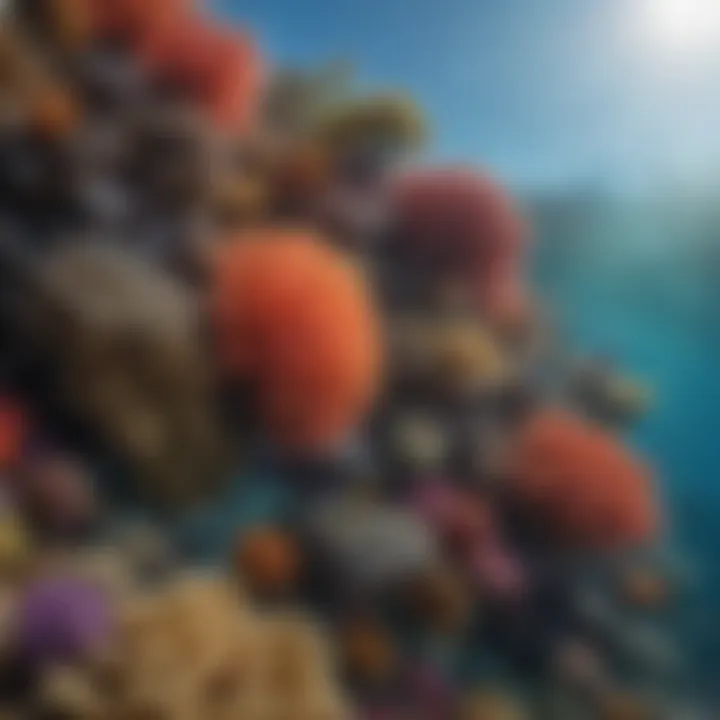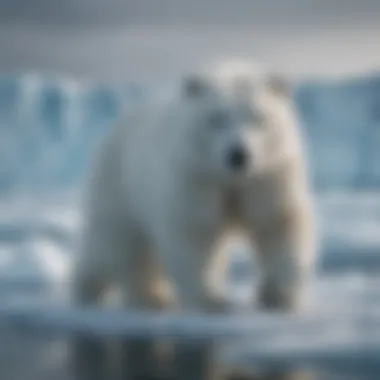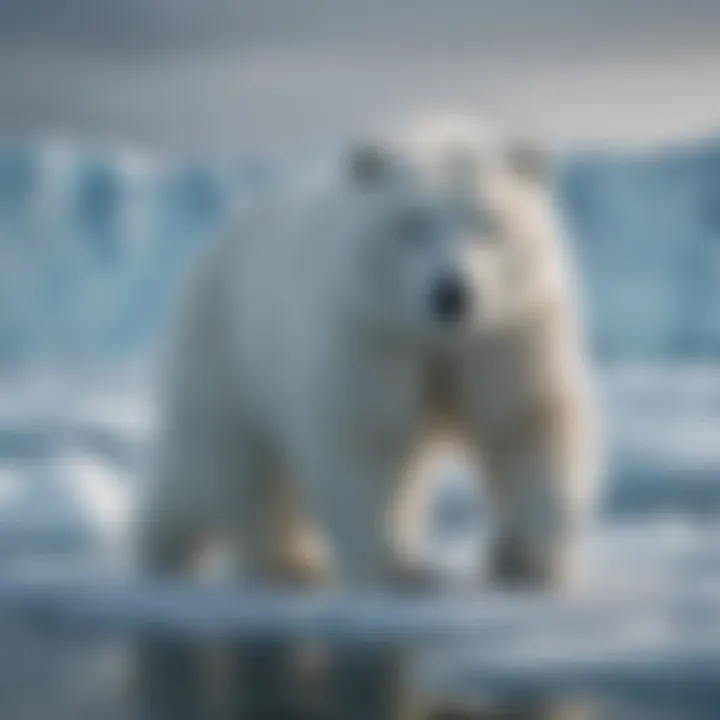Exploring the Four Oceans: A Watersports Perspective


Intro
The vastness of the world's waters presents an exhilarating playground for sports enthusiasts. Each ocean offers not just waves and currents, but unique characteristics that shape the activities conducted upon their surfaces. From the mighty Pacific to the icy reaches of the Arctic, watersports enthusiasts have the chance to experience a spectrum of environments and challenges.
Understanding the distinct features of the Pacific, Atlantic, Indian, and Arctic Oceans can enrich the watersports experiences. This knowledge helps not only in choosing the right location for activities but also in enhancing safety and enjoyment while navigating these waters. Each ocean carries its own environmental quirks and cultural significance, which, when explored, can open new doors for athletes and adventurers alike.
In this article, we'll delve into the nuances of gear necessary for enjoying these vast aquatic expanses, focus on techniques tailored to the specific context of each ocean, and examine how our oceans perform a crucial role not only ecologically but also culturally. This exploration is intended for everyone from seasoned athletes to curious beginners aiming to broaden their horizons.
Gear Recommendations
When considering the four oceans, the gear one uses can be the difference between a pleasant experience and a dangerous one. Depending on your skill level and the specific conditions of the ocean you choose, the gear will vary.
Essential Gear for Beginners
For those just diving into the watersports realm, it’s important to start with the basics:
- Snorkel and Mask: A comfortable and reliable snorkel and mask allow for exploration just beneath the surface, giving you a taste of aquatic life without requiring extensive training.
- Life Jacket: Safety should always be a top priority. A life jacket or buoyancy aid provides essential support, especially in challenging waters.
- Wetsuit: Depending on the region, a wetsuit helps maintain body heat and protect against harsh marine elements.
- Surfboard or Paddleboard: If your interest lies in surfing or paddleboarding, beginning with a soft-top surfboard is often the right way to go. The stability is key for newcomers.
Investing in quality gear at this stage can lead to a more enjoyable and safer experience.
Advanced Equipment for Professionals
For the more seasoned watersports practitioners looking to take their ocean game up a notch, advanced equipment includes:
- High-Performance Surfboards: These are tailored for various wave conditions and come in varying sizes and shapes to suit different skill levels.
- Kitesurfing Gear: This includes kites, boards, and harnesses designed to tackle the wind and water conditions unique to specific oceans.
- Advanced Diving Equipment: Include high-quality tanks, regulators, and underwater gauges for those pursuing deeper explorations in the Indian or Pacific Oceans.
Owning and maintaining this equipment not only boosts your performance but also enhances your overall sessions across different oceanic environments.
Techniques and Tips
Knowing the right techniques can drastically change how one participates in watersports. Each ocean demands specific skills and knowledge from its enthusiasts.
Skill Improvement Strategies
- Practice Consistently: Regular practice helps in refining skills. The more time spent in the water, the better your understanding of it becomes.
- Watch and Learn: Observing experienced athletes can provide invaluable insights. Consider joining local groups or forums on platforms like Reddit to gain wisdom from seasoned ocean athletes.
Safety Practices and Guidelines
To maintain safety:
- Know the Weather: Always check the weather conditions before heading out. Storms can brew suddenly and significantly affect ocean behaviors.
- Understand Local Wildlife: Being aware of local marine life is crucial, as certain creatures might pose risks or require specific caution.
"Preparation is the key to a memorable and safe experience in the water."
Each ocean serves as a platform for a different style of watersport, shaped by environmental factors and personal growth. By grasping the gear needed and mastering techniques pertinent to each ocean, enthusiasts can immerse themselves in a world where water meets adventure and excitement.
Prologue to the World’s Oceans
The oceans are a vital cradle for life and a playground for adventure. Globally, they cover about 71% of the Earth’s surface, making their study not just a scientific endeavor but also an exploration into our shared adventures and histories. Understanding our oceans is crucial because they influence climate, weather patterns, and even economic activities. This section lays the groundwork for appreciating the four major oceans—Pacific, Atlantic, Indian, and Arctic—through a watersports lens.
Defining Oceans
Oceans are expansive bodies of saltwater that separate continents and provide critical habitat for countless marine species. They are more than just a barrier; they are dynamic environments teeming with life. Each ocean has its unique characteristics based on geographical location, depth, and climate.
An ocean is different from a sea in size, depth, and biological diversity. Seas are smaller and often partially enclosed by land. For instance, the Mediterranean Sea is bounded by Europe, Africa, and Asia, while the Pacific Ocean stretches from the Arctic to the Antarctic and is the largest ocean.
Instead of limiting our understanding to mere definitions, it's important to appreciate the oceans' role in culture and sport. From the early Polynesians navigating the Pacific to modern-day surfers riding the Atlantic's waves, oceans have been a vital part of human experience.
The Four Major Oceans
When we explore the four major oceans, we begin to see how each one shapes watersports uniquely.
- Pacific Ocean: With its vast expanse, it offers some of the best surfing spots, vibrant marine life, and numerous islands for kayaking.
- Atlantic Ocean: Known as a cultural melting pot, it’s a hub for sailing routes and fishing expeditions, rich in tradition and biodiversity.
- Indian Ocean: Its warmth and unique habitats, like coral atolls, create ideal conditions for activities such as stand-up paddleboarding and kite surfing.
- Arctic Ocean: Though often seen as remote, it offers thrilling experiences like polar diving and ice kayaking, allowing adventurous spirits to explore its frigid beauty.
In a world that constantly changes, our oceans remain a source of inspiration and adventure. As we delve deeper into each ocean, we can appreciate the myriad ways they shape our activities, economies, and cultures, while also recognizing the importance of their preservation for future generations.
"The ocean stirs the heart, inspires the imagination, and brings eternal joy to the soul." - Robert Wyland
Through this exploration, we unveil not only recreational opportunities but also the essential ecological roles these oceans play. Let's dive into the distinct wonders of the Pacific, Atlantic, Indian, and Arctic Oceans as the article unfolds.
The Pacific Ocean: Vastness and Diversity
The Pacific Ocean stands as an unparalleled titan among water bodies, captivating not just due to its sheer size but also for its diverse ecosystems and the myriad of activities it supports. Covering more area than all of Earth's land combined, it offers a rich tapestry of opportunities for watersport enthusiasts. Whether it's the thrill of riding the waves, kayaking through serene coastlines, or diving into underwater sanctuaries, the Pacific is a paradise for those seeking adventure. Understanding its unique characteristics can enhance one’s appreciation of not only the ocean’s beauty but also the ecological importance it holds for our planet.
Geographical Overview
Home to various climates and landscapes, the Pacific Ocean stretches from the Arctic in the north to the Southern Ocean in the south, encompassing a diverse range of geographical features. From the volcanic islands of Hawaii to the tranquil shores of Fiji, this ocean presents an array of ecosystems and habitats. The Pacific is often a highway for weather patterns, influencing global climate by modulating temperatures and precipitation. Its depth—averaging around 12,080 feet—contains some of the most stunning geographic wonders known to humankind.
Rich Ecosystems
Richness in biodiversity defines the Pacific Ocean, where coral reefs and vibrant marine life thrive alongside conservation efforts aimed at sustaining these natural treasures.
Coral Reefs
Coral reefs in the Pacific are like underwater cities bustling with life, serving as habitats for countless marine species. They are not just visually stunning; they play a critical role in coastal protection and serve as nurseries for fish. A key characteristic of coral reefs is their resilience, which, despite the escalating pressures from climate change and pollution, still supports a flourishing diversity of life. However, the delicate balance of these ecosystems is at risk. Understanding the fragility of coral reefs encourages a sense of responsibility among watersports enthusiasts who often engage with these environments.
Marine Life
Diversity in marine life is perhaps one of the most fascinating aspects of the Pacific Ocean. Schools of colorful fish, majestic pelagic species like manta rays, and even the gentle giants of the sea, the whales, showcase the ocean's incredible biodiversity. This abundance not only attracts divers and snorkelers but also plays a critical role in the marine food web. Maintaining the health of these ecosystems is crucial, as they face threats from overfishing and habitat loss; engaging in responsible watersports can help mitigate some of these challenges.
Conservation Efforts
Efforts to conserve the Pacific's marine ecosystems show a growing awareness of environmental stewardship. Initiatives like marine protected areas, research programs, and community-based conservation strategies reflect a proactive approach that allows watersport enthusiasts to participate actively in preserving this natural resource. The importance of these initiatives cannot be overstated; they safeguard not just the marine flora and fauna but also the very activities that draw people to these waters. By engaging in responsible practices, enthusiasts can contribute to the ongoing conservation of their aquatic playground.
Watersports Opportunities


The Pacific is a veritable playground for watersports, offering numerous activities from high-energy surfing to serene kayaking.
Surfing Hotspots
The Pacific's vast waves beckon surfers from all corners of the globe. Renowned spots like Pipeline in Hawaii or the Gold Coast in Australia not only provide fantastic surfing experiences but are also steeped in local culture. Surfers find themselves connecting with the rhythm of the ocean, crafting a relationship that goes beyond just sport. The thrill of conquering big waves is matched by the responsibility surfers have to respect coastal ecosystems and local communities.
Kayaking Adventures
For those who prefer a quieter approach, kayaking allows exploration of the calmer waters of the Pacific. Kayakers can navigate through mangroves, explore hidden coves, or paddle alongside marine wildlife, providing a unique perspective on the ocean’s beauty. Safety is paramount in this sport, as tides and weather can shift unexpectedly, highlighting the need for proper knowledge and respectful practices within the natural environment.
Scuba Diving Locations
The Pacific Ocean is a diver’s dream, housing some of the most breathtaking underwater sites on the planet. Locations like the Great Barrier Reef or the waters around Indonesia serve as incredible venues for scuba diving, offering a chance to get up close and personal with marine life. Divers often encounter vibrant coral gardens, breathtaking underwater topographies, and unparalleled biodiversity. The unique allure of these sites lies in their ability to educate divers about marine conservation while creating lasting memories beneath the surface.
"The ocean stirs the heart, inspires the imagination, and brings eternal joy to the soul." - Robert Wyland
Overall, the Pacific Ocean is more than a vast expanse of water; it is a dynamic environment filled with opportunities and challenges that entice watersport aficionados to engage deeply. With every wave ridden, every breath taken below the surface, and every paddle stroke made, the participants not only enjoy the thrill of adventure but also nurture a bond with the ocean that both beckons and demands respect.
The Atlantic Ocean: A Cultural Crossroads
The Atlantic Ocean holds a place of profound importance in human history and cultural exchange. Stretching from the Arctic to the Antarctic, it acts as a major conduit between continents, shaping economies, climates, and societies. This ocean is not merely a physical barrier but a vibrant crossroads where ideas, people, and traditions have mingled for centuries. Understanding the cultural significance of the Atlantic Ocean involves appreciating its historical role in trade, exploration, and the melting pot of cultures it fosters.
Geographical Significance
Geographically, the Atlantic Ocean is remarkable for its width, reaching about 3,200 kilometers at its broadest point. It separates the Americas from Europe and Africa, influencing weather patterns and ocean currents that play a critical role in global climate systems. The interplay of land and water in this area forms numerous islands and archipelagos that serve as gateways to world cultures. Notably, the Gulf Stream, a warm ocean current originating in the Gulf of Mexico, flows northeast, moderating temperatures in Western Europe and impacting trade routes. The Atlantic is, thus, more than just an ocean—it's a lifeline connecting diverse regions.
Biodiversity Challenges
Concerning biodiversity, the Atlantic Ocean faces several challenges that could impact its ecosystems and those who enjoy its waters.
Overfishing
Overfishing is a pressing form of environmental strain that stems from high demand for seafood. Once bountiful stocks, such as tuna and cod, have faced rapid depletion, significantly altering the marine ecosystem. This is crucial for watersports enthusiasts as well; the health of the fish population often dictates the buoyancy of fishing experiences available. If the fish are scarce, the charm of a fishing trip diminishes drastically. On top of this, dropping fish populations can lead to an imbalance in marine ecosystems, affecting the entire food web. This serves as an important reminder that while enjoyment of the ocean’s resources is vital, sustainable practices must guide any engagement.
Pollution
Pollution in the Atlantic Ocean is a growing concern, presenting severe challenges for marine life and those who partake in watersports. Whether it’s plastic debris, toxic runoff, or oil spills, the impact of pollutants can be palpable in various ecosystems. For divers and swimmers, encountering trash beneath the surface detracts from the natural beauty of the ocean, transforming serene adventures into disheartening experiences. The spread of pollutants can also compromise the health of coral reefs, making preservation efforts all the more vital. Recognizing pollution as a real threat can encourage the watersports community to engage in clean-up efforts and advocacy for better waste management.
Climate Change Impacts
Climate change presents yet another challenge, influencing the Atlantic’s wave patterns, currents, and weather events. Rising sea levels and altered pH levels threaten not only marine habitats but also coastal communities that rely on the ocean for their livelihoods and recreational activities. For athletes and adventurers, changes in ocean conditions can modify the types of watersports available throughout different times of the year. By understanding the implications of climate change, watersports enthusiasts can be more equipped to adapt their practices and also take part in broader environmental efforts aimed at protecting the Atlantic Ocean.
Watersports Adventures
The Atlantic Ocean also provides a myriad of watersport adventures, showcasing the vast recreational potential of its waters.
Sailing Routes
Sailing routes across the Atlantic are legendary, offering thrill for sailors of all levels. The ease of access to beautiful harbors and varied wind patterns makes it a prime playground for sailing lovers. From the charming coastlines of the Caribbean to the dramatic coasts of Ireland, sailors find a wealth of routes that cater to their interests, whether they seek adventure or relaxation. A journey across the Atlantic can be an enlightening experience for athletes, teaching them about navigation while they enjoy the fresh air and expansive views.
Fishing Experiences
Fishing enthusiasts find a rich variety of experiences throughout the Atlantic. Locations such as the Grand Banks near Newfoundland and the Bahamas’ blue holes provide some of the best fishing waters in the world. The experience doesn’t simply end with casting a line; it often evolves into storytelling, sharing methods, and savoring fresh catches. Each fishing trip becomes a personal narrative, connecting individuals not only to the ocean but also to each other. However, the challenge remains—how to fish sustainably?
Freediving Excursions
Freediving excursions in the Atlantic Ocean open up a different realm of exploration. Without the heavy gear, divers can glide smoothly beneath the waves, discovering submerged wonders. The thrill of diving into historical shipwrecks or vibrant coral gardens makes every dive a unique experience. Freediving, while exhilarating, brings attention to the need for conservation, as divers witness firsthand the importance of protecting marine habitats to preserve the magic of these underwater adventures.
"The Atlantic is not merely water; it is a gathering point for cultures, stories, and adventures that span generations."
The Indian Ocean: A Gem of the South
The Indian Ocean is more than just a stretch of water; it is a tapestry woven from ancient trade routes, vibrant cultures, and diverse ecosystems. This ocean, encompassing a vast area between Africa, Asia, and Australia, plays a vital role in both regional and global watersports. Its warm waters, rich biodiversity, and variety of landscapes make it a sought-after destination for adventure enthusiasts. This section will explore its geography, unique marine habitats, and the popular activities that turn the Indian Ocean into a playground for watersport aficionados.
Geography and Climate
The Indian Ocean is characterized by its distinct geographical features, which include vast islands such as Mauritius, Seychelles, and Madagascar. Its warm waters are nourished by the sun, creating a tropical climate that appeals to divers and sailors alike. With a mixture of calm bays and more turbulent regions, the geography enables different types of watersports to flourish.
Strong monsoons influence the climate patterns; while they can bring challenges, they also create opportunities for thrilling watersports. For example, between May and September, the winds in the southern areas can create ideal conditions for kite surfing—a favored activity among enthusiasts. Additionally, the ocean is rich in currents and tides that can influence sailing routes and fishing experiences.
Unique Marine Habitats
Atolls
Atolls are one of the most intriguing features of the Indian Ocean. These ring-shaped reefs harbor stunning coral formations, becoming vibrant underwater cities that are teeming with life.
Their unique characteristics, such as lagoons and surrounding reefs, contribute to rich biodiversity, making atolls a beneficial choice for snorkelers and divers seeking to experience an underwater paradise. However, they are not without their challenges; rising sea levels pose a significant threat to these fragile ecosystems. The conservation of these areas is of utmost importance for maintaining marine life which depends on them.
Seagrass Meadows
Seagrass meadows are another vital component of the Indian Ocean's ecosystem. These underwater plants are critical for providing shelter and food for numerous marine species. They also act as natural filters, improving water quality.
The meadows are a popular choice for eco-conscious watersport activities such as kayaking and paddleboarding because they enhance the experience of viewers who want to enjoy picturesque views below the surface. However, they face threats from pollution and coastal development, making awareness and conservation efforts necessary for their survival.
Biodiversity Hotspots
The Indian Ocean is home to numerous biodiversity hotspots—areas where the variety of species is particularly high. These regions are crucial not only for the marine ecosystem but also for watersports, as they provide diverse environments for exploration.
Coral reefs, mangroves, and unique fish species contribute to making it an interesting choice for both recreational and research activities. Furthermore, protection of these hotspots is critical; safeguarding these areas assures a sustainable future for watersports while preserving precious marine life.
Popular Watersports Activities
Stand-Up Paddleboarding
Stand-up paddleboarding (SUP) in the Indian Ocean offers a leisurely way to connect with nature. The calm waters near beaches or coves provide ideal conditions for this sport, attracting both novices and seasoned paddlers.


This activity allows participants to explore hidden coves and observe marine life from a unique vantage point. Stand-up paddleboarding is a great option for fitness enthusiasts looking for a mix of exercise and relaxation amid stunning scenery. One drawback, however, is that paddling may be challenging in areas with strong currents or wind, so it is essential to choose locations wisely.
Kite Surfing
Kite surfing combines elements of surfing, wakeboarding, and paragliding, making it an exhilarating choice for thrill-seekers. The Indian Ocean is famed for its strong winds, especially in locations like the Maldives and Mauritius, making it a prime spot for this sport. Not only does it provide adrenaline-pumping actions, but it also allows enthusiasts to harness the ocean's energy. Nonetheless, safety precautions should be top priority, as with any extreme sports activity.
Yachting Adventures
Yachting in the Indian Ocean can be a luxurious experience unlike any other. With a backdrop of stunning islands and idyllic coastlines, yachting not only offers relaxation but also adventure. Whether it’s day charters or longer voyages, there is a sense of freedom on open waters.
Travelers can indulge in exploring unique destinations, while having the opportunity to participate in fishing or diving trips along the way. One must keep in mind that the costs can add up—chartering a yacht might not be accessible for everyone, but when possible, it beats being stuck on land.
The Indian Ocean remains a unique playground, bridging cultures, nature, and adventure for those who dare to explore its depths.
The Arctic Ocean: The Final Frontier
The Arctic Ocean stands as a realm of profound intrigue and harsh beauty. Its icy expanse is not just a barrier; rather, it plays a vital role in the global ecosystem and human activity. As the least explored ocean, it presents unique challenges and opportunities, especially for watersport enthusiasts. The resilience of its ecosystems and the adaptations of its inhabitants provide a fascinating study into survival against the odds. Understanding the nuances of the Arctic Ocean encourages both respect and appreciation for one of Earth’s final frontiers.
Geothermal Dynamics
Beneath the icy surface of the Arctic Ocean, geothermal activity exists that influences the entire marine environment. These geological processes heat the surrounding waters, creating pockets of warmth in an otherwise frigid setting. This phenomenon is essential as it supports a variety of life forms that might not survive in cooler temperatures. The melting of permafrost and the rise of underwater vents produce nutrient-rich waters, fostering a localized ecosystem brimming with life. For adventurers, the unique interactions between geothermal activity and ice formation add an element of unpredictability to explorations.
Ecological Importance
The ecological significance of the Arctic Ocean cannot be overstated. It offers crucial habitats for a diverse array of species, some of which are uniquely adapted to thrive despite severe conditions.
Ice Caps and Glaciers
Ice caps and glaciers serve as critical indicators of climate change and have a profound impact on global sea levels. These immense ice structures act as natural reservoirs of freshwater and also play a crucial role in regulating the Earth's climate. One striking characteristic of the Arctic ice is its reflective quality, which significantly impacts heat absorption levels in the ocean.
This is a double-edged sword; while they protect the planet from overheating, their melting poses a threat to rising sea levels worldwide. Exploring these areas through watersports can provide a rare, firsthand perspective of climate change, and the pristine environment emphasizes the need for conservation efforts. However, the precarious nature of ice can be a distinct hazard for any activities.
Species Adaptations
Adaptations of species in the Arctic showcase the resilience of nature. Many animals, like the polar bear and seal, have developed thick layers of blubber and dense fur to endure bone-chilling temperatures. This ability to thrive under relentless conditions makes them remarkable subjects of study. Furthermore, the Arctic environment has led to unique feeding strategies and behaviors that are only seen in this region.
The fascinating characteristic of these adaptations is how interconnected they are with environmental changes. As ice continues to retreat, these species may find themselves struggling for survival. Watersport activities can facilitate awareness about these species and the unique challenges they face, deepening appreciation for marine biology and conservation needs.
Human Impact
Human activities, particularly climate change, are imposing considerable stress on the Arctic Ocean environment. From pollution to shipping traffic, the consequences are far-reaching. A key characteristic of this impact includes the disruption of migratory patterns for marine life and the potential for oil spills that can devastate local habitats.
The rise of industrial activities in the Arctic also poses ethical questions about exploitation versus conservation. In engaging in watersports, individuals can contribute to the dialogue on how we treat naturally fragile ecosystems. While adventurous, these activities should be executed with an essence of responsibility and awareness of the underlying human influence on these precious waters.
Watersports in Extreme Environments
The Arctic offers unique watersport experiences defined by extreme conditions and breathtaking scenery. The ultimate charm lies in navigating through icy landscapes, making each expedition unforgettable.
Ice Kayaking
Ice kayaking presents one of the most exhilarating ways to explore this starkly beautiful ocean. Navigating through icebergs and around floating glacial fragments creates a refreshing mix of danger and beauty. The key feature of this sport is the ability to experience the landscape from a vantage point that few encounter.
However, challenges abound—navigating shifting ice and treacherous conditions requires significant skill and respect for the environment. Those who dare often find it to be a deeply rewarding experience, offering a unique connection with nature.
Polar Diving
Polar diving opens up a wondrous view of underwater life—a world that teems with color and movement beneath the stark ice. Divers can witness the interplay of sunlight filtering through the ice, illuminating the vibrant marine diversity, which can include everything from unique algae to native fish species adapted for cold waters.
While it can be a breathtaking experience, divers must also be aware of the requisite training and safety measures necessary to explore such extreme environments. This sport highlights how delicate and precious the marine ecosystems are, thus emphasizing the importance of sustainable practices.
Expedition Cruises
Expedition cruises in the Arctic offer a more laid-back approach while still immersing travelers in majestic ice-covered landscapes. These cruises often blend education with adventure, giving tourists insight into the ocean's significance through presentations and guided excursions.
The unique feature of these cruises is their ability to potentially induce goodwill and inspire conservation movements through connections made during the journey. However, like any activity in fragile environments, there’s a distinct responsibility attached to ensuring we preserve these places for future generations.
The Arctic Ocean provides a stark reminder of both beauty and fragility, challenging us to tread lightly as we explore its wonders.
The Interconnectedness of Oceans
Understanding the intertwined nature of oceans is as vital as knowing their individual features. Each of the four major oceans—the Pacific, Atlantic, Indian, and Arctic—doesn’t exist in isolation. They work together like a well-oiled machine, influencing not just the marine ecosystems, but also human activities, weather patterns, and climate. This connection holds immense significance, especially for those involved in watersports. Recognizing how currents flow from one ocean to another can enhance the experience for adventurers and provide critical insights into conditions they might encounter.
Global Ocean Currents
Global ocean currents are akin to the highways of the seas. They carry warm water from tropical regions towards the poles and cold water from poles back to the tropics. This movement plays a crucial role in regulating Earth's climate. For a watersports enthusiast, being aware of these currents can make the difference between a smooth sailing and an experience that goes awry due to unpredictable weather. Take the Gulf Stream, for example; it’s a powerful current in the Atlantic that warms Western Europe, making its climate milder than one would expect at such latitudes.
Environmental Impact of Oceans
Sea-Level Rise
Sea-level rise isn't just a buzzword; it’s a pressing issue with far-reaching implications. As glaciers melt and ocean temperatures rise, the sea level encroaches on coastal regions. This development jeopardizes habitats and human settlements alike. For watersport activities, rising sea levels may change surf conditions, alter the geography of beaches, and even affect access to launch points and harbors. Coastal communities need to adapt, but to what extent? It’s an essential conversation for those who cherish activities like surfing or kayaking in their local environments.
Climate Regulation
The oceans act as earth's natural air conditioner. They absorb a significant amount of carbon dioxide and heat. This mechanism provides a buffer against climate change impacts. For sailors navigating through variable weather or divers exploring delicate underwater ecosystems, understanding climate regulation is key. Variations in ocean temperature can directly affect marine life, causing shifts in fish stocks, which in turn influences sport fishing and other activities
Carbon Sequestration
Oceans also play a critical role in carbon sequestration, a natural process where carbon dioxide is absorbed and stored in oceanic ecosystems. This process is vital for mitigating climate change. For the water sports community, it presents an opportunity to appreciate and promote sustainable practices. Engaging in activities like coral reef conservation or marine biodiversity protection helps maintain these ecosystems, ensuring that future generations can enjoy the same aquatic adventures. Without a doubt, every small effort counts in protecting the marine environment.
"The health of our oceans is directly tied to the health of our planet. Each wave that crashes onto a shore carries with it a wealth of knowledge about our environment."
In summary, acknowledging the interconnectedness of oceans not only enriches our understanding of watersport experiences but also emphasizes the responsibility each participant has in maintaining these majestic bodies of water. Whether it's through participation in conservation initiatives or simply choosing sustainable practices while enjoying one's favorite water activities, the ocean's future is in our hands.
Cultural Significance of Oceans


The oceans are not just massive bodies of water; they hold immeasurable cultural significance across the globe. From ancient times to the present day, oceans have played pivotal roles in shaping civilizations, forging connections between people, and influencing lifestyles. This section delves into the profound impact oceans have within various cultures and how they continue to intertwine with human activities, particularly in the realm of watersports.
Oceans in Mythology and Folklore
Oceans have always sparked the imagination of humans, leading to rich mythological narratives. Consider the stories of Poseidon in Greek mythology, the god of the sea who wielded a trident to control oceanic chaos. Cultures around the world have their own myths that encapsulate the mysteries of the sea, representing strength, danger, and adventure. The indigenous people of the Pacific Islands often hold the ocean as sacred, viewing it as a provider and protector. These myths not only illustrate a deep cultural connection with the water but also remind us of nature’s unpredictability and beauty.
Through folklore, we learn about the dangers of the sea and the importance of respecting its power. Coastal communities often pass down tales of shipwrecks or heroic voyages, serving as both cautionary tales and sources of pride. They cement the bond between people and the ocean, highlighting its role as both an ally and adversary. Such stories contribute to the tapestry of cultural heritage linked to watersports, inspiring thrill-seekers to brave the waves while understanding the legacies embedded in the waters they navigate.
Oceans and Human Activities
The oceans affect human activities in many aspects: economically, socially, and environmentally. Their vastness supports numerous traditions and practices that sustain communities and lifestyles.
Fishing Traditions
Fishing isn’t merely a means to survive for many cultures; it’s a way of life. Coastal towns thrive on fishing traditions, passed down through generations. These practices often reflect the adaptability of people to their environments. For instance, the fishing techniques of the Inuit in the Arctic involve intricate knowledge of ice patterns and fish behavior that have been refined over centuries.
The key characteristics of fishing traditions lie in their cultural rituals and the community bonds they foster. Many fishing communities celebrate the harvest through festivals, showcasing their deep-rooted connections to the ocean. This makes fishing not just an economic activity but an integral part of life.
However, fishing can also have its downsides. The rise of industrial fishing often leads to overfishing, threatening sustainability. Understanding traditional fishing practices is essential for promoting sustainable approaches in the watersport community.
Transport and Trade
It’s hard to deny the impact oceans have had on transport and trade throughout history. The seas have served as highways connecting different regions, facilitating the exchange of goods, ideas, and cultures. Traditional maritime routes, like the Spice Route, opened doors to cross-cultural interactions that shaped world history.
The unique feature of oceanic transport is its ability to support large cargo movements. Even today, shipping remains the backbone of global trade as it allows for the efficient transportation of goods across continents. However, with the growth of shipping, environmental issues come to light, such as pollution and overfishing, raising questions about sustainability in maritime trade.
Tourism Development
Tourism development around oceans creates a double-edged sword. Coastal areas benefit enormously from the influx of tourists eager to engage in watersports, driving local economies and creating jobs. Destinations like Hawaii or the Caribbean thrive due to their ocean-based attractions.
The key characteristic of ocean tourism is its ability to offer a variety of activities, from sailing and surfing to diving and snorkeling. These activities not only engage visitors but deepen their appreciation for the ocean's beauty and importance.
Nonetheless, the rapid expansion of tourism can also lead to environmental degradation. Coral reefs suffer from over-exploitation due to mass tourism, showing that while oceans foster economic growth, careful planning is crucial to preserve their integrity for future generations.
"The ocean stirs the heart, inspires the imagination, and brings eternal joy to the soul."
In examining these cultural significance elements, one sees that oceans serve as more than just a backdrop to human activities. They are integral to shaping cultural identities, practices, and traditions and continue to offer opportunities for adventure in the ever-evolving landscape of watersports.
Future of Our Oceans
The topic of the future of our oceans holds immense significance as it serves as a lens through which we can view the myriad of challenges and opportunities that await us and future generations. Climate change, overfishing, and pollution are just a few of the critical issues at play. These factors not only threaten marine biodiversity but also have profound impacts on various water sports that many individuals cherish and rely upon. Understanding and implementing strategic conservation efforts, innovations in watersports, and engaging community initiatives will be core to ensuring that our oceans remain healthy and vibrant for activities that countless adventurers enjoy.
Conservation Strategies
The crux of safeguarding the future of our oceans lies in the effective implementation of conservation strategies. These strategies are often multidisciplinary, blending science, policy, and community engagement. For instance, marine protected areas play a crucial role in allowing marine ecosystems to flourish without the pressures of human activity.
- Reducing Pollution: Appropriate waste disposal systems and stricter regulations can minimize ocean pollution from urban runoff.
- Sustainable Fishing Practices: Techniques such as catch and release, and limiting fishing seasons help fish populations maintain a balance.
- Education and Advocacy: Raising awareness among water sports enthusiasts can foster a culture of respect and responsibility towards marine environments.
These conservation strategies nurture resilience in marine ecosystems. This resilience not only benefits marine life but also ensures that water sports can flourish within these spaces, offering thrilling experiences without the hefty price of environmental degradation.
Innovations in Watersports
In a world poised on the precipice of environmental crisis, innovations in watersports shine a beacon of hope. These innovations can significantly reduce the ecological footprint of water-based activities while enhancing the thrill of adventure.
Eco-Friendly Gear
The rise of eco-friendly gear has been a game changer in the watersports community. For example, manufacturers are now producing boards made from recycled plastics or sustainable materials.
One key characteristic of such gear is the use of biodegradable materials, which contribute to a lowered environmental impact. Option to use options like plant-based epoxies or recycled fiber composites highlight a shift towards sustainability.
Advantages include durability and a reduced carbon footprint, making them a popular choice among environmentally conscious athletes. However, there can be drawbacks, like sometimes higher costs or limited availability in certain regions. Yet, when considered against the backdrop of preserving our oceans, it's a sacrifice many are willing to make.
Sustainable Practices
Sustainable practices in watersports represent a growing movement among enthusiasts and instructors alike. These practices encompass everything from reducing single-use plastics at events to promoting adherence to localized conservation guidelines.
A hallmark of sustainable practices is minimal environmental impact—such as opting for paddleboards that leave no trace on the waterway or utilizing organic materials in clothing.
These methods not only align with the goals of forming a more ecological watersports community, but they, too, foster a sense of connection and stewardship among participants. While some practices require additional effort or planning, the benefits to marine ecosystems are undeniable.
Community Initiatives
Community initiatives in oceanside towns can significantly shape the future playful watersports landscape. Local groups often spearhead actions to clean up beaches or advocate for better environmental laws affecting marine areas.
A critical aspect of these initiatives is community engagement, encouraging local residents and visitors alike to participate in actions that protect the water and its inhabitants.
Through clean-up days, educational workshops, and marine awareness programs, communities can affect positive change. While there might be challenges—such as rallying consistent volunteers—the long-lasting effects on local ecosystems and economies make these efforts worthwhile.
"The ocean stirs the heart, inspires the imagination, and brings eternal joy to the soul." - Wyland
As we look ahead at the oceans' health, these contributions from conservation strategies, innovations in watersports, and community initiatives offer not just hope but actionable pathways. With every conscious decision made today, we can forge a road towards a thriving aquatic future that champions both adventure and sustainability.
Culmination
The importance of oceans cannot be understated, particularly when looking through the lens of watersports. As this article has outlined, each of the four major oceans—Pacific, Atlantic, Indian, and Arctic—offers unique experiences and ecological significance that should resonate with outdoor enthusiasts and adventure seekers alike. The interplay between local biodiversity and human activity highlights a delicate balance that we must strive to maintain.
The Enduring Appeal of Oceans
Oceans stand as a symbol of both adventure and tranquility. They draw people in with their vastness, beckoning thrill-seekers and those simply wishing to unwind. The catch with this appeal is understanding the richness they harbor beneath the surface. From coral reefs vibrant with life to open waters that challenge skilled sailors, the oceans provide an almost endless canvas for exploration. Nothing compares with the feeling of kayaking through calm waters at sunrise or surfing on a sweltering afternoon—experiences that form lasting memories.
People often say, "Life is a beach," implying a desire to escape the rigors of daily life. Whether it’s enjoying a leisurely day of fishing or embarking on an electrifying diving excursion, oceans furnish a plethora of activities that cater to various interests. As we navigate these waters, it’s crucial to appreciate not only the thrill they offer but also the responsibilities we carry as stewards of these environments.
Encouragement for Exploration
Exploration is synonymous with growth; therefore, diving into the aquatic wonders of our oceans can be both rewarding and enlightening. Engaging in watersports opens doors to new friendships, cultures, and a deeper understanding of marine ecosystems. Think about it: every surf session, sailing trip, or diving experience unravels a new layer of oceanic knowledge.
- Start small. Local kayaking can give you insights about nearby ecosystems and foster awareness about local environmental issues.
- Consider joining community workshops or clubs focusing on ocean conservation; getting involved provides firsthand experience and a chance to contribute positively.
- Challenge yourself with new activities. If you've never tried kite surfing, why not? It's a delightful way to interact with the winds and waves.
"The ocean stirs the heart, inspires the imagination, and brings eternal joy to the soul."
As we embark on our journeys, let’s stay curious and respectful. The oceans are a treasure trove ready to be explored, and while we indulge in these activities, let’s never forget the importance of preserving their beauty for future generations. Ultimately, every wave, tide, and undertow tells a story, waiting for us to discover.















